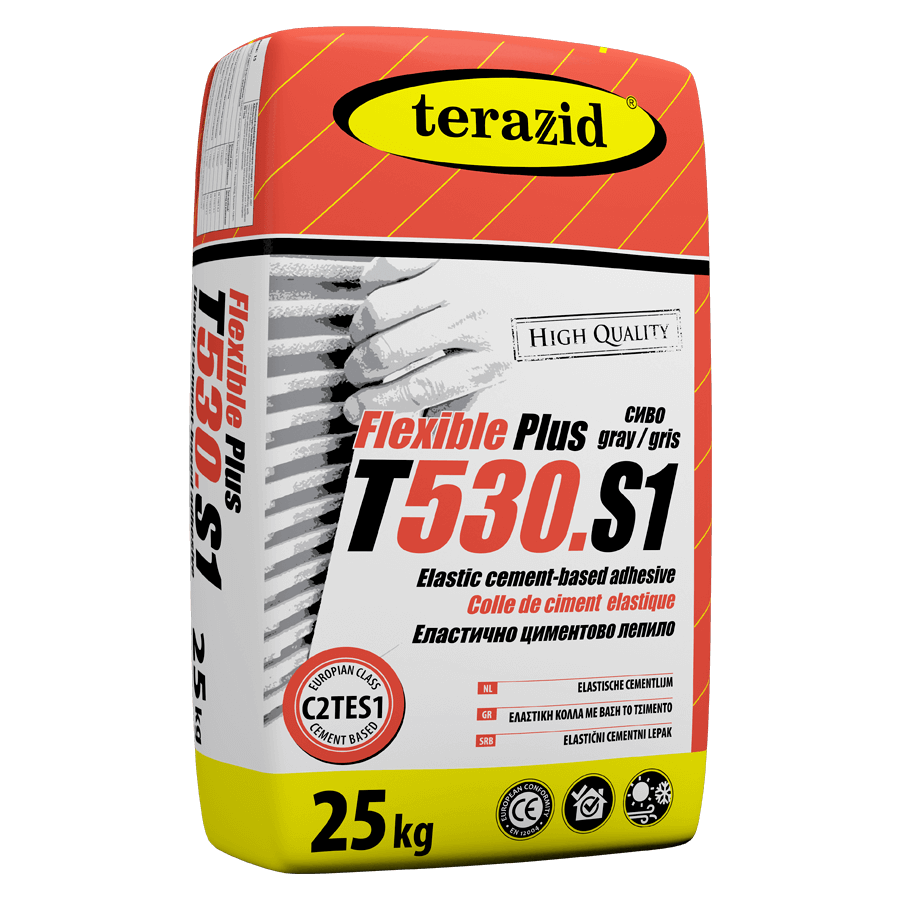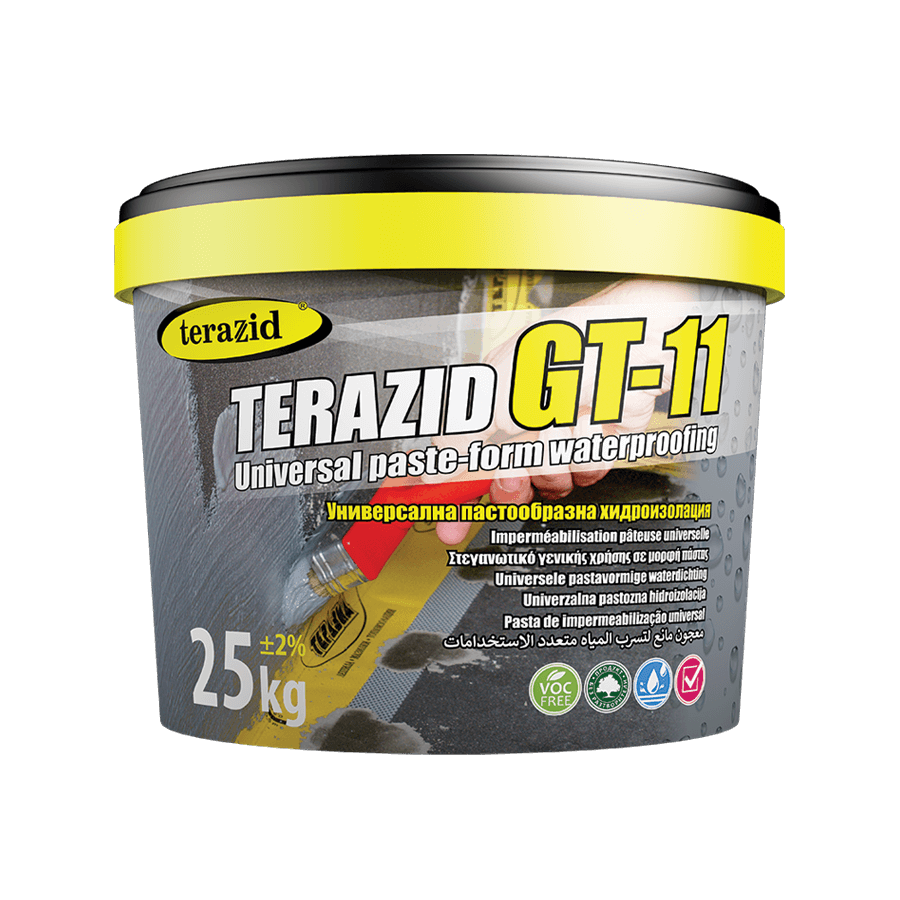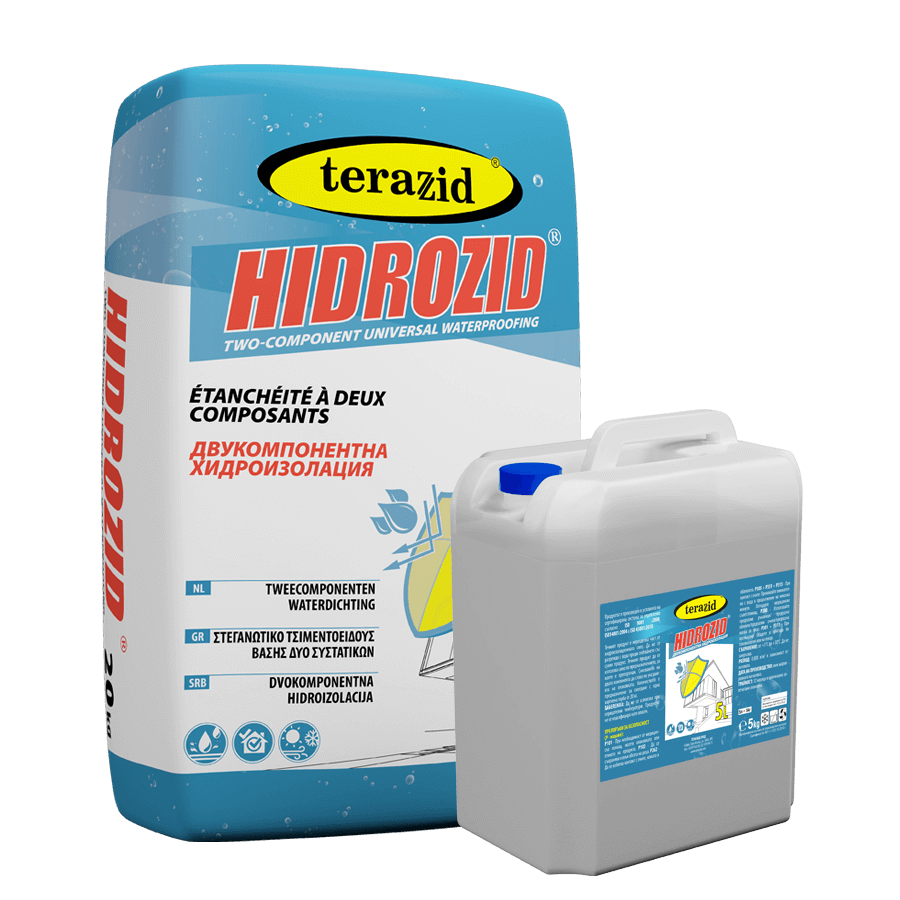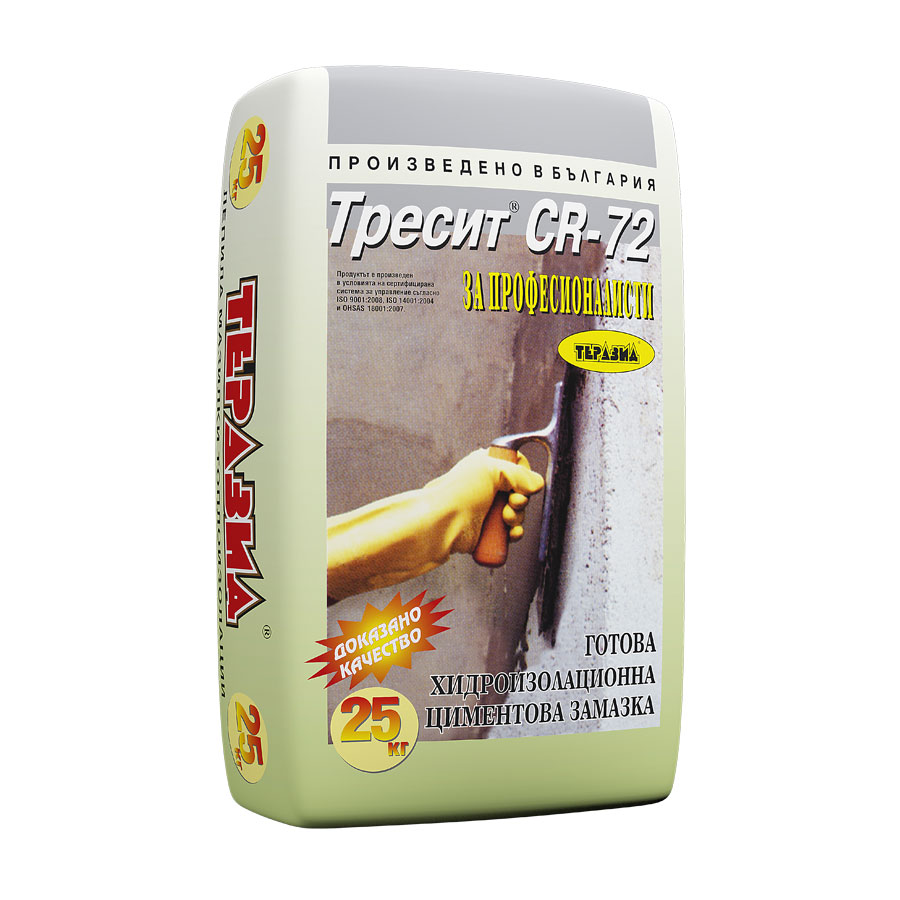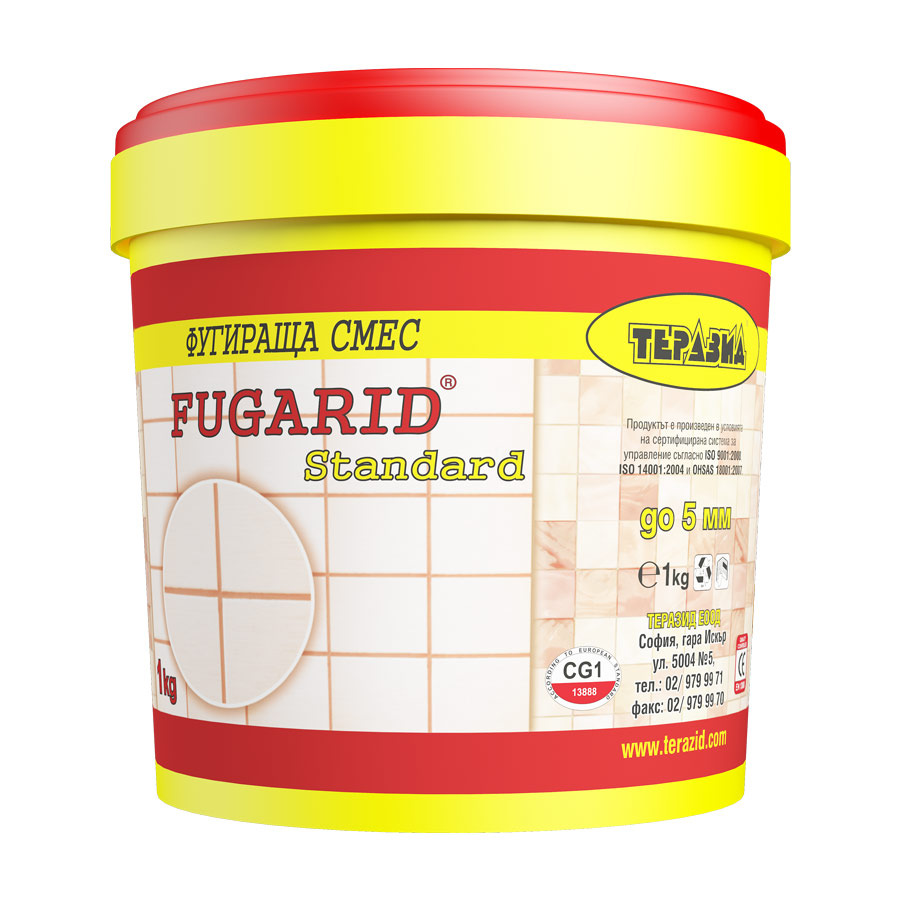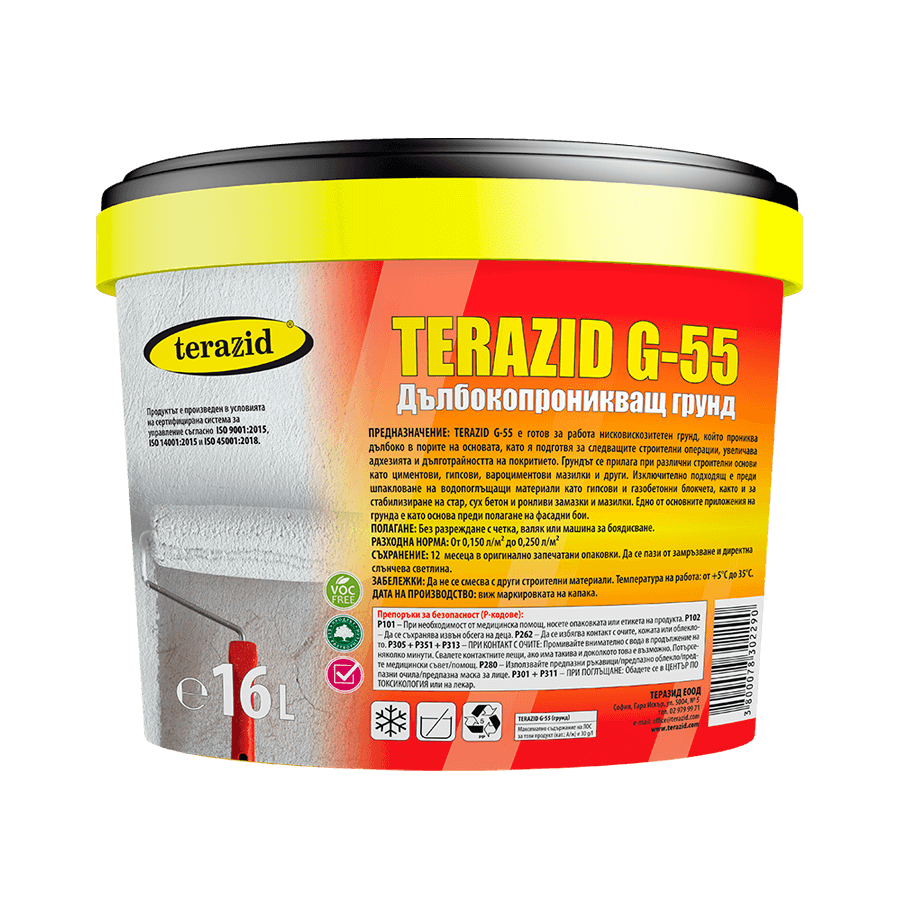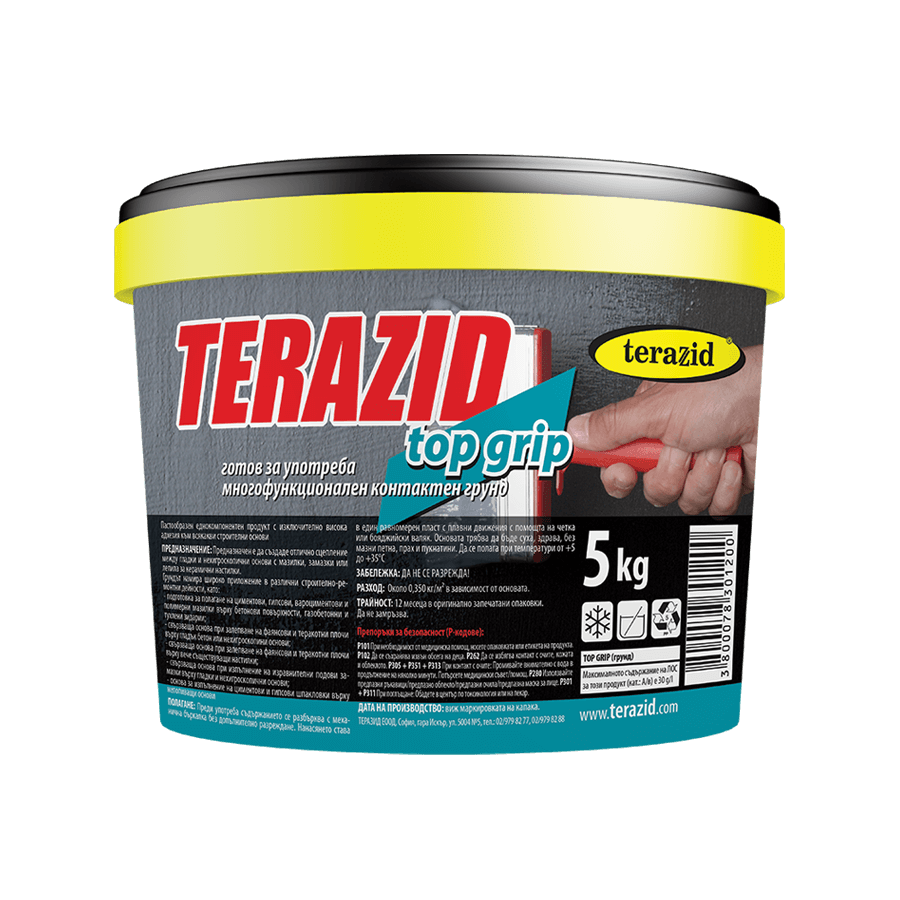Flexible Plus T530.S1 – Elastic cement-based tile adhesive
Class C2TES1 – According to EN 12004:2007
Improved elastic cement-based adhesive with reduced sliding and extended open time for interior and exterior application
Colours : grey, white
Category: Adhesives for ceramic and stone floorings and coverings
Description:
PURPOSE
The high-quality elastic adhesive FLEXIBLE PLUS T530.S1 has a composition with improved strength properties, achieved by inserted monofibers and special additives. It is designed for secure bonding of all types of ceramic and stone floorings, providing a strong and elastic base on critical and deformable substrates and on surfaces exposed to mechanical or thermal expansions. FLEXIBLE PLUS T530.S1 has excellent hydrophobic characteristics. All high qualities of the product determine its application for:
• interior and exterior bonding of ceramic and natural stone tiles
• bonding of tiles on many different types of construction bases (concrete, plasterboard, plasters, screeds, etc.)
• bonding of tiles on critical and deformable construction bases, exposed to all weather conditions
• bonding of tiles – faience over faience, terracotta over faience, marble over terracotta
• bonding of ceramic and stone tiles on waterproofing (swimming pools, water reservoirs, etc.)
• bonding of heavy tiles with dimensions up to 100 cm x 100 cm
• bonding of ceramic and stone tiles over underfloor heating systems
Declaration of Performance – grey (DoP)
Flexible Plus T530.S1 – Elastic cement-based tile adhesive
Declaration of Performance - grey (DoP)
FLEXIBLE PLUS T530.S1 (grey)
DECLARATION OF PERFORMANCE
According with Regulation (EU) №305/2011
№ 20180223-D
1. Unique Identification Code of Product Type
FLEXIBLE PLUS T530.S1 (grey)
2. Type, Batch or Serial Number or Other Element Allowing Identification of the Construction Product as Required under Article 11, Paragraph 4 of Regulation (EU) №305/2011
Improved elastic cement-based adhesive with reduced sliding and extended open time for interior and exterior application
/batch number printed on the package/
3. Intended Use or Uses of the Construction Product in Accordance with the Applicable Harmonized Technical Specification, as Foreseen by the Manufacturer
Elastic cement-based adhesive for bonding terracotta, granite, ceramic and stone floorings and facings, heavy tiles, and tiles with dimensions up to 100 x 100 cm.
4. Name, Registered Trade Name or Registered Trade Mark and Contact Address of the Manufacturer, as Required under Article 11, Paragraph 4 of Regulation (EU) №305/2011
TERAZID Ltd.
5 „5004” Str., Gara Iskar, Sofia 1528, Bulgaria
Tel. +35929799971
Email: office@terazid.com
5. Where Applicable, Name and Contact Address of the Authorized Representative Whose Mandate Covers the Tasks Specified in Article 12, Paragraph 2 of Regulation (EU) №305/2011
Not applicable.
6. System or Systems of Assessment and Verification of Constancy of Performance of the Construction Product as Set Out in Regulation (EU) №305/2011 for Construction Products, Annex V
System 3
7. In Case of the Declaration of Performance Concerning a Construction Product Covered by Harmonized Standard
EN 12004 – Adhesives for tiles – Requirements, evaluation of conformity, classification and designation.
The notified body 2032 – Building Research Institute (NISI), Sofia, has performed initial type testing, based on samples provided by the manufacturer.
8. Declared Performance
| Reaction to fire | Class A1 | EN 13820 |
| Initial tensile bond strength after 28 days | 2.4 N/mm² | EN 12004-2 |
| Tensile bond strength after water immersion | 1.1 N/mm² | EN 12004-2 |
| Tensile bond strength after heat treatment | 2.8 N/mm² | EN 12004-2 |
| Tensile bond strength after 25 freeze-thaw cycles | 1.3 N/mm² | EN 12004-2 |
| Reduced slip | 0.3 mm | EN 12004-2 |
| Extended open time – Tensile bond strength after 40 min | 0.9 N/mm² | EN 12004-2 |
| Transversal deformation | 2.6 mm | EN 12004-2 |
9. The performance of the product identified in points 1 and 2 is in conformity with the declared performance in point 8.
This declaration of performance is issued under the sole responsibility of the manufacturer identified in point 4.
Declaration of Performance – white (DoP)
Flexible Plus T530.S1 – Elastic cement-based tile adhesive
Declaration of Performance - white (DoP)
FLEXIBLE PLUS T530.S1 (white)
DECLARATION OF PERFORMANCE
According with Regulation (EU) №305/2011
№ 20180223-D
1. Unique Identification Code of Product Type
FLEXIBLE PLUS T530.S1 (white)
2. Type, Batch or Serial Number or Other Element Allowing Identification of the Construction Product as Required Under Article 11, Paragraph 4 of Regulation (EU) №305/2011
Improved elastic cement-based adhesive with reduced sliding and extended open time for interior and exterior application
/batch number printed on the package/
3. Intended Use or Uses of the Construction Product in Accordance with the Applicable Harmonized Technical Specification, as Foreseen by the Manufacturer
Elastic cement-based adhesive for bonding terracotta, granite, ceramic, and stone floorings and facings, heavy tiles, and tiles with dimensions up to 100 x 100 cm.
4. Name, Registered Trade Name or Registered Trade Mark and Contact Address of the Manufacturer, as Required Under Article 11, Paragraph 4 of Regulation (EU) №305/2011
TERAZID Ltd.
5 „5004” Str., Gara Iskar, Sofia 1528, Bulgaria
Tel. +35929799971
Email: office@terazid.com
5. Where Applicable, Name and Contact Address of the Authorized Representative Whose Mandate Covers the Tasks Specified in Article 12, Paragraph 2 of Regulation (EU) №305/2011
Not applicable.
6. System or Systems of Assessment and Verification of Constancy of Performance of the Construction Product as Set Out in Regulation (EU) №305/2011 for Construction Products, Annex V
System 3
7. In Case of the Declaration of Performance Concerning a Construction Product Covered by Harmonized Standard
EN 12004 – Adhesives for tiles – Requirements, evaluation of conformity, classification, and designation.
The notified body 2032 – Building Research Institute (NISI), Sofia, has performed initial
type testing, based on samples provided from the manufacturer.
8. Declared performance
| Reaction to fire | Class A1 | EN 13820 |
| Initial tensile bond strength after 28 days | 2.1 ± 0.1 N/mm² | EN 12004-2 |
| Tensile bond strength after water immersion | 1.6 ± 0.1 N/mm² | EN 12004-2 |
| Tensile bond strength after heat treatment | 2.4 ± 0.1 N/mm² | EN 12004-2 |
| Tensile bond strength after 25 freeze-thaw cycles | 2.1 ± 0.1 N/mm² | EN 12004-2 |
| Reduced slip | 0.2 mm | EN 12004-2 |
| Extended open time – Tensile bond strength after 40 min | 1.2 N/mm² | EN 12004-2 |
| Transversal deformation | 2.8 ± 0.2 mm | EN 12004-2 |
9. The performance of the product identified in points 1 and 2 is in conformity with the declared performance in point 8.
This declaration of performance is issued under the sole responsibility of the manufacturer identified in point 4.
Technical Data Sheet (TDS)
Flexible Plus T530.S1 – Elastic cement-based tile adhesive
Technical Data Sheet (TDS)
FLEXIBLE PLUS T530.S1
Elastic cement-based tile adhesive
According to the requirements of EN 12004:2007+А1:2012 – class C2 TES1
Improved cement-based adhesive with reduced sliding and extended open time for interior and exterior application
PURPOSE
The high-quality elastic adhesive FLEXIBLE PLUS T530.S1 has a composition with improved strength properties, achieved by inserted monofibers and special additives.
It is designed for secure bonding of all types of ceramic and stone floorings, providing a strong and elastic base on critical and deformable substrates and on surfaces exposed to mechanical or thermal expansions.
FLEXIBLE PLUS T530.S1 has excellent hydrophobic characteristics. All high qualities of the product determine its application for:
-
Interior and exterior bonding of ceramic and natural stone tiles
-
Bonding of tiles on many different types of construction bases (concrete, plasterboard, plasters, screeds, etc.)
-
Bonding of tiles on critical and deformable construction bases, exposed to all weather conditions
-
Bonding of tiles – faience over faience, terracotta over faience, marble over terracotta
-
Bonding of ceramic and stone tiles on waterproofing (swimming pools, water reservoirs, etc.)
-
Bonding of heavy tiles with dimensions up to 100 cm x 100 cm
-
Bonding of ceramic and stone tiles over underfloor heating systems
PROPERTIES
-
Extended open time (for work)
-
Elastic
-
Resistant to high temperatures
-
Moisture resistant
-
Resistant to linear extensions
PREPARATION OF THE BASE
Before application of FLEXIBLE PLUS T530.S1, the base should be dry, well cleaned, and strong. Application over oil (grease) stains, dust, and other contaminants is not allowed. Bases with high absorption should be wetted or primed in advance.
With FLEXIBLE PLUS T530.S1 you can bond directly on concrete, cement screeds, mosaics and plasters, gas concrete, gypsum plasterboard, gypsum facer, etc.
When bonding tiles over old tiles, the base must be treated with TERAZID G-22 in advance.
APPLICATION AND PROCESSING
For the complete dissolution of 25 kg of FLEXIBLE PLUS T530.S1, around 6.75 liters of water are required. Into a preliminary prepared container with water, the necessary amount of dry mixture should be poured and stirred with a mechanical mixer until a homogeneous mass is achieved.
Thus, the stirred mixture is left to stay for 10 minutes so that it gets “mature,” after that it is stirred once again and it is ready for work.
For economic and quality work, it is desirable to work with a notched mortarboard with an appropriate edge size, depending on the size of the tiles and the type of the base.
For achieving the optimal adhesion with the base, it is required that the adhesive is applied on a minimum of 60% of the tile back.
When working outside, it is better to apply the adhesive on both the tiles and the base. It is not recommended to dip ceramic tiles in water.
Time for correction is about 40 minutes.
CONSUMPTION
-
From 3 kg/m² to 7 kg/m², depending on the tile dimensions
WORKING TOOLS
-
Bucket
-
Electrical stirrer
-
Trowel
-
Mortarboard
WEATHER CONDITIONS FOR APPLICATION
-
The minimum 24-hour temperature of the air and the base should not be less than +5˚C, and the maximum should not be higher than +30˚C.
-
It is not recommended to apply FLEXIBLE PLUS T530.S1 at high levels of air humidity, or when the forecast predicts rain or during rain.
-
It is recommended to use TEKALIT antifreeze additive when the temperature variations between day and night are large and there is a risk of reaching negative temperatures at night.
FORM OF DELIVERY
-
Dry mixture in paper packages of 25 kg
NOTES
-
Characteristics and technical data of the product, pointed out in this Technical Data Sheet, are defined at a standard temperature (20˚C) and relative humidity (50%). In other weather conditions, the technological time for some of the processes mentioned above could be shorter or longer.
-
The information about the product is based on the practical experience of the manufacturer and the technical tests in specialized laboratories.
-
Do not mix with other building materials.
-
All hazards and precautionary statements about FLEXIBLE PLUS T530.S1 can be checked in the Safety Data Sheet of the product.
STORAGE
-
12 months in the originally sealed packages, in a dry and ventilated store. It is recommended to store on pallets.
| Characteristic | Performance |
|---|---|
| Colour | grey or white |
| Form (aggregate state) | dry powder |
| Base | cement |
| Open time for work | around 40 minutes |
| Ready for jointing | floor- after 24 h, walls- after 8 h |
| Ready for walking | after 24 hours |
| Reaction to fire | A1 |
| Bulk density | 1.5 kg/l |
| Application thickness | up to 10 mm |
| Initial tensile bond strength after 28 days | 2.4 N/mm² |
| Tensile bond strength after water immersion | 1.1 N/mm² |
| Tensile bond strength after heat treatment | 2.8 N/mm² |
| Tensile bond strength after 25 freeze-thaw cycles | 1.3 N/mm² |
| Transverse deformation | 2.6 mm |
Material Safety Data Sheet (MSDS)
Flexible Plus T530.S1 – Elastic cement-based tile adhesive
Material Safety Data Sheet (MSDS)
FLEXIBLE PLUS T530.S1
MATERIAL SAFETY DATA SHEET
According to (EU) 2020/878
1. Identification of the Substance/Mixture and of the Company
1.1. Product identifier – FLEXIBLE PLUS T530.S1
UFI: MJS2-Y011-H00Q-KFK9
1.2. Relevant identified uses of the substance or mixture and uses advised against
Cement-based adhesive for ceramic and stone floorings and facings.
1.3. Details of the supplier of the safety data sheet
TERAZID Ltd.
5, 5004 Street, Gara Iskar, 1528 Sofia, Bulgaria
tel. +3592/9799971, office@terazid.com
1.4. Emergency telephone number:
112
UMHATEM “Pirogov” (toxicology): +359 2/ 915 44 11
UMHATEM “Pirogov” (ER): +359 2/ 915 42 33; +359 2/ 915 42 13
Hours of operation – 24/7
pirogov@pirogov.bg www.pirogov.eu
2. Hazards identification
2.1. Classification of the substance or mixture
2.1.1. Classification in accordance with Regulation (ЕC) 1272/2008 – CLP:
-
Skin Irrit. 2 – Causes skin irritation
-
Eye Dam. 1 – Causes serious eye damage
-
STOT SE 3 – May cause respiratory irritation
2.2. Label elements

Signal word: Danger
Hazard statements:
-
H315 – Causes skin irritation.
-
H318 – Causes serious eye damage.
-
H335 – May cause respiratory irritation.
Precautionary statements:
-
P102 – Keep out of reach of children.
-
P261 – Avoid breathing dust/fume/gas/mist/vapours/spray.
-
P280 – Wear protective gloves/protective clothing/eye protection/face protection.
-
P302 + P352 – IF ON SKIN: Wash with plenty of soap and water.
-
P305 + P351 + P315 – IF IN EYES: Rinse cautiously with water for several minutes. Remove contact lenses, if present and easy to do. Continue rinsing.
-
P332 + P313 – If skin irritation occurs: Get medical advice/attention.
2.3. Other hazards
-
Contains Portland cement. When reacting with water, it creates an alkaline medium.
-
Does not contain soluble Cr (VI) in a quantity greater than 0.0002% within the period of storage.
-
In case the storage conditions are not suitable or the product has expired, Portland cement can cause skin sensitization (H317 or EUH 203).
-
May cause damage to materials made of aluminium or other non-precious metals.
3. Composition/information on ingredients
3.1 Substances – N/A
3.2 Mixtures
-
General chemical description: Dry mixture based on Portland cement, mineral fillers, and modifying additives, which are not classified as hazardous, according to Regulation (ЕC) 1272/2008 – CLP.
Information on hazardous ingredients according to Regulation (EC) 1272/2008 – CLP:
| CAS № | EC № | Ingredient name | Content % | Signal word | H-codes |
|---|---|---|---|---|---|
| 65997-15-1 | 266-043-4 | Portland cement | 20-40 % | Danger | H315, H317, H318, H335 |
4. First aid measures
4.1. Description of first aid measures
-
General notes: No special protective equipment is required for the first aider. Avoid contact with the moistened mixture.
-
Inhalation: Remove the victim to fresh air. If the symptoms remain, get qualified medical attention.
-
Skin contact: Wash the contact area with soap and water. Remove the contaminated clothing. If skin irritation or rash occurs: Get medical advice/attention.
-
Eye contact: Rinse with plenty of water for a period of at least 15 minutes and open eyelid. Remove contact lenses, if present. Continue rinsing with water. Do not rub the contaminated eye to avoid eventual further damage to the cornea. In case of necessity, get medical attention (ophthalmologist).
-
Ingestion: Clean mouth with water and afterwards drink plenty of water. Do NOT induce vomiting. Obtain medical attention (toxicology).
4.2. Most important symptoms and effects, both acute and delayed
-
This product contains cement. Contact between cement and body fluids (e.g., sweat, eye moisture) can cause irritation or burns.
-
If large amounts of dust are inhaled over a long period of time, the product may cause irritation of the respiratory tract and increase the risk of lung disease.
-
In case of skin contact, the product may react with moisture (sweat) and cause irritation, significant inflammation, scabs, swellings, and others.
-
In case of eye contact, the product may cause serious eye injury, such as corneal clouding or iris lesions.
4.3. Indication of any immediate medical attention and special treatment needed
-
Follow the advice given in section 4.1. In case of accident or unwellness, seek medical attention immediately (show the product label or Safety Data Sheet if possible).
5. Firefighting measures
FLEXIBLE PLUS T530.S1 is a non-combustible and non-explosive product.
5.1. Extinguishing media
The mixture is non-flammable and non-combustible, both in the delivery state and during operation, as well as during the performance period.
-
Suitable extinguishing media: Suitable for the surrounding environment and the type of fire – water mist, water spray, dry powder, foam, carbon dioxide.
-
Unsuitable extinguishing media: Water under pressure.
5.2. Special hazards, arising from the substance or mixture
Non-known. The mixture is non-combustible and non-explosive.
5.3. Advice for firefighters
Fire-fighters should wear appropriate protective equipment and self-contained breathing apparatus.
Separately collect the contaminated water from extinguishing the fire so that it does not enter the drain system.
Move undamaged packages out of the danger area if it can be done safely.
6. Accidental Release Measures
6.1. Personal precautions, protective equipment and emergency procedures
6.1.1. For non-emergency personnel
Ventilate the area. Avoid contact with eyes and skin. Do not inhale dust. Wear suitable protective equipment.
6.1.2. For emergency responders
No special measures are required.
6.2. Environmental precautions
Do not allow to be released in the environment. If the mixture gets into an aqueous environment, it can cause an increase in pH above 9, which will lead to a danger for the environment.
Take measures to prevent pollution of surface and underground water, soil, as well as discharge into the sewers.
6.3. Methods and material for containment and cleaning up
Remove the spilled amount mechanically using a vacuum suction unit, or shovel into bags, by taking measures to prevent the formation of high concentrations of dust in the air.
Keep the material dry if possible. Store the collected quantities in special, tightly closed, and labeled containers.
After that, hand them over to persons holding a permit in accordance with Article 37 of the Waste Management Act.
7. Handling and Storage
7.1. Precautions for safe handling
Use the product only for its main purpose. Do not eat, drink, or smoke while working with the product.
Avoid skin and eye contact. Ventilate the area. Keep dust levels to a minimum.
Wash hands thoroughly after use. Do not allow to be released in the environment or the sewer system.
7.2. Conditions for safe storage, including any incompatibilities
The substance should be stored under dry conditions. Any contact with water and moisture should be avoided.
Keep out of reach of children. Keep away from food and drink.
7.3. Specific usage – N/A.
8. Exposure Controls/Personal Protection
8.1. Control parameters
| Name | Affecting | Allowable level |
|---|---|---|
| Портланд цимент | respiratory | 5 mg/m³ air inhaled dust particles for 8 hours |
8.2. Exposure controls
8.2.1. Appropriate engineering controls
Avoid dusting during use. Provide appropriate ventilation. Provide suitable vacuuming
equipment.
8.2.2. Personal protective equipment
| Section | Description |
|---|---|
| 8.2.2.1. Eye and face protection | Avoid contact with eyes. Use tight-fitting safety glasses. |
| 8.2.2.2. Skin protection | Avoid skin contact. Use alkali-resistant protective gloves. Use protective standard working clothes fully covering skin. Use boots and appropriate clothing with long sleeves. |
| 8.2.2.3. Respiratory protection | Avoid inhalation of dust. Use a dust protective mask, filter (FFP2). |
8.2.3. Environmental exposure controls
No special measures are necessary. Do not allow to be released in the environment, the sewer system, or underground waters.
Observe the dustiness during work, according to the limit normative values.
9. Physical and Chemical Properties
9.1. Information on basic physical and chemical properties
-
a) Physical state: Powder
-
b) Colour: White or white
-
c) Odour: Odourless
-
d) Melting point/freezing point: Melting point > 1250 °C
-
e) Initial boiling point and boiling range: N/A
-
f) Flammability: Non-flammable, non-combustible
-
g) Upper/lower flammability or explosive limits: N/A
-
h) Flash point: N/A
-
i) Auto-ignition temperature: N/A
-
j) Decomposition temperature: N/A
-
k) pH (20 °C): ≈ 12
-
l) Viscosity: N/A
-
m) Solubility in water: Partially soluble
-
n) Partition coefficient: n-octanol/water: N/A
-
o) Vapour pressure: N/A
-
p) Density or relative density: ≈ 1.7 g/cm³ (bulk density)
-
q) Vapour density: N/A
-
r) Explosive properties: Non-explosive
-
s) Particle characteristics: N/A
9.2. Other information
No data.
10. Stability and reactivity
10.1. Reactivity
Alkaline reaction with water. When mixed with water, the product hardens into a stable mass that is not reactive under normal conditions.
10.2. Chemical stability
The product is stable, under normal conditions of storage and use.
10.3. Possibility of hazardous reactions
No possibility of hazardous reactions.
10.4. Conditions to avoid
Protect from moisture during storage and transport.
10.5. Incompatible materials
Acids, ammonium salts, aluminium or other non-precious metals. When reacting with non-precious metals, hydrogen is released.
10.6. Hazardous decomposition products
Does not decompose into hazardous products.
11. Toxicological information
11.1. Information on hazard classes as defined in Regulation (EC) 1272/2008 – CLP
-
Acute toxicity (dermal) – Limit test, rat, 24 hours exposure, 5 mg/m³ – no acute toxicity observed. Based on the available data, the mixture is not classified in the “Acute toxicity (dermal)” category.
-
Acute toxicity (Inhalation) – Limit test, rabbit, 24 hour exposure, 2,000 mg/kg body weight – no lethal outcome. Based on the available data, the mixture is not classified in the “Acute toxicity (inhalation)” category.
-
Acute toxicity (oral) – Based on the available data, the mixture is not classified in the “Acute toxicity (oral)” category.
-
Skin irritation/Corrosion – In contact with wet skin, the Portland cement, in the mixture composition, may cause roughening, cracking or splitting of the skin. Prolonged contact combined with rubbing can cause severe burns. Some people may develop eczema after exposure to wet cement dust, caused by the high pH value, which can cause irritant contact dermatitis. Based on the available data, the mixture is classified as irritating to skin (H315 – Causes skin irritation).
-
Serious eye damage/eye irritation – The Portland cement, in the mixture composition, causes various reactions on the cornea, with an estimated irritation index of 128. The product may cause serious eye injury such as corneal clouding or iris lesions. Direct contact with cement can cause damage to the cornea due to mechanical stress. It can also cause irritation or inflammation, which may occur immediately or later. Direct contact with larger quantities of dry cement or splashes of wet cement can cause effects that range from moderate eye irritation (eg, conjunctivitis or blepharitis) to chemical burns and blindness. Based on the available data, the mixture entails a risk of serious damage to the eye (H318 – Causes serious eye damage).
-
Respiratory or skin sensitization – Some people may develop eczema when exposed to wet cement dust, caused by the mixture pH value or by an immunological reaction to soluble Cr (VI) – an allergic reaction. The result can appear in a variety of forms, ranging from a mild rash to severe dermatitis. The product does not contain soluble Cr (VI) into a quantity greater than 0,0002 % within the period of storage, from which it follows that an immunological reaction and an allergic sensitizing effect are not expected during this period.
-
No indication of respiratory tract sensitization. Based on the available data, the mixture is not classified in the “Respiratory Sensitization” category.
-
Mutagenicity – There is no indication. Based on the available data, the mixture is not classified in the “Germ cell mutagenicity” category.
Carcinogenicity – There is no evidence for direct link between Portland cement and carcinogenic diseases. The epidemiological literature does not identify cement as an expected human carcinogen. Based on the available data, the mixture is not classified in the “Carcinogenicity” category.
Reproductive toxicity – Based on the available data, the mixture is not classified in the “Reproductive toxicity” category.
STOT – specific target organ toxicity (single exposure) – Cement dust can irritate the throat and respiratory tract. Coughing, sneezing, and breath shortness may occur after exposures at occupational exposure limits. Overall, the evidence clearly shows that occupational exposure to cement dust leads to deficits in respiratory function. However, currently available evidences are insufficient to establish the connection between the dose and these effects.
STOT – specific target organ toxicity (repeated exposure) – Prolonged inhalation of cement dust above the occupational exposure limit can lead to coughing, breath shortness and chronic obstructive changes in the respiratory tract. No chronic effects were observed at low concentration. Based on the available data, the mixture is not classified in the “Specific target organ toxicity (repeated exposure)” category.
Inhalation hazard – N/A.
11.2. Other information
No data. The mixture is not an aerosol.
12. Ecological information
12.1. Toxicity
The product is not hazardous for the environment. The ecotoxicological test with Portland cement on water flea – Daphnia magna and on Selenastrum algae showed little toxicological impact. Therefore, LC50 and EC50 values cannot be determined. Adding large amounts of the mixture to water, however, can cause the pH value to rise and therefore can, under certain conditions, be toxic to aquatic organisms.
12.2. Persistence and degradability
Not relevant for inorganic substances.
12.3. Bio-accumulative potential
Not relevant for inorganic substances.
12.4. Mobility in soil
Not relevant for inorganic substances.
12.5. Results of PBT and vPvB assessment
Not relevant for inorganic substances.
12.6. Endocrine disrupting properties
N/A.
12.7. Other adverse effects
No data.
13. Disposal considerations
13.1. Waste treatment methods
Do not dispose in surface water, soil or the sewer system. Do not treat as domestic waste. Residual quantity or spilled material should be collected in special, tightly closed, labelled containers and temporarily stored. Residual quantities of dry material can also be mixed with water, avoiding any contact with the skin, and treated as concrete waste after hardening. The wastes should be stored temporarily and after that they should be handed over to persons, holding a permit in accordance with Article 37 of the Waste Management Act.
The used packages are only meant for packing this product. They should not be reused for other purposes. After usage, empty the packages completely and treat them as paper packaging waste.
EWC – European Waste Catalogue:
10 13 06 – Particulates and dust.
10 13 14 – Waste concrete and concrete sludge.
15 01 01 – Paper and cardboard packaging.
14. Transport information
It is not dangerous goods according to RID, ADR, ADNR, IMDG, IATA-DGR and no classification is required.
It should be transported under the respective rules for transportation, concerning the respective type of transport and ensuring the safety of the load.
No special precautions are necessary, except those mentioned in point 8.
14.1. UN number or ID number – N/A.
14.2. UN proper shipping name – N/A.
14.3. Transport hazard class(es) – N/A.
14.4. Packing group – N/A.
14.5. Environmental hazards – N/A.
14.6. Special precautions for user – Avoid any release of dust during transportation.
14.7. Transport in bulk according to IMO instruments – N/A.
15. Regulatory information
15.1. Safety, health and environmental regulations/legislation specific for the substance or mixture.
The product is classified as a mixture according to REACH and is not subject to registration.
The mixture contains Portland cement. Does not contain soluble Cr (VI) in an amount greater than 0.0002 % within the period of storage (REACH, Annex XVII, point 47).
National regulations:
▪ Law of protection from the harmful Impact of the chemical substances and preparations.
▪ Environmental protection law.
▪ Health and safety at work law.
▪ Regulation №3 on the minimum requirements for safety and protection of the workers when using personal protective equipment at the workplace.
▪ Waste management law.
▪ Regulation №2 from 23.07.2014 for waste classification.
▪ Regulation on the order and the method of classification, labelling and packaging of chemical substances and preparations.
European regulations:
▪ Regulation (EC) 1907/2006 concerning the Registration, Evaluation, Authorisation and Restriction of Chemicals (REACH).
▪ Regulation (ЕC) 1272/2008 – CLP from 16th December 2008, concerning the classification, labelling and packaging of substances and mixtures.
▪ Regulation (EU) 2020/878 from 18 June 2020, amending Annex II to Regulation (EC) 1907/2006 concerning the Registration, Evaluation, Authorisation and Restriction of Chemicals (REACH).
15.2. Chemical safety assessment.
No chemical safety assessment has been performed for the mixture.
16. Other information
16.1. Indication of changes
Format in accordance with Regulation (EU) 2020/878 from 18 June 2020, amending Annex II to Regulation (EC) 1907/2006 concerning the Registration, Evaluation, Authorisation and Restriction of Chemicals (REACH).
The mixture is classified according to Regulation (EC) 1272/2008 – CLP from 16th December 2008, concerning the classification, labelling and packaging of substances and mixtures.
16.2. Classification and procedure used to obtain the qualification of mixtures according to Regulation (EC) 1272/2008 – CLP
| Description | Test Data |
|---|---|
| Causes skin irritation, Skin Irrit. 2 (H315) | Test data |
| Causes serious eye damage, Eye Dam. 1 (H318) | Test data |
| May cause respiratory irritation, STOT SE 3 (H335) | Test data |
16.3. Abbreviations and acronyms
| Abbreviation | Description |
|---|---|
| ADR/RID | Agreements Concerning the International Carriage of Dangerous Goods by Rail (RID) and by Road (ADR) and the Joint meeting of RID Safety Committee and the Working Party on the Transport of Dangerous Goods |
| CAS | Chemical Abstracts Service in American Chemical Society |
| CLP | Regulation (EC) 1272/2008 from 16th December 2008, concerning the classification, labelling and packaging of substances and mixtures |
| DNEL | Derived no-effect level |
| EC50 | Half maximum effective concentration |
| ECHA | European Chemicals Agency |
| EINECS | European Inventory of Existing Chemical Substances |
| EPA | Effective air filter |
| EWC | European Waste Catalogue |
| FF P | Filtering type „facepiece” for fine particles (single usage) |
| FM P | Filtering mask for fine particles with filter cartridge |
| HEPA | Type of high efficiency air filter |
| IATA | International Air Transport Association |
| IMDG | International Maritime Dangerous Goods |
| LC50 | Lethal concentration at which 50% of test animals die |
| PBT | Persistent, Bio-accumulative and Toxic |
| PNEC | Derived no-effect concentration |
| REACH | Regulation (EC) 1907/2006 concerning the Registration, Evaluation, Authorisation and Restriction of Chemicals |
| RPE | Respiratory protective equipment |
| SE | Single exposure |
| STP | Sewage treatment plant |
| STOT | Specific target organ toxicity |
| UFI | Unique Formula Identifier |
| vPvB | Very persistent and Very bio-accumulative |
| w/w | Weight per weight (mass percentages) |
16.4. Main references and sources of literature data
-
Portland Cement Dust – Hazard assessment document EH75/7, UK Health and Safety Executive – link
-
Observations on the effects of skin irritation caused by cement, Kietzman et al, Dermatosen, 47, 5, 184-189 (1999)
-
European Commission’s Scientific Committee on Toxicology, Ecotoxicology and the Environment (SCTEE) opinion of the risks to health from Cr(VI) in cement (European Commission, 2002)
-
Epidemiological assessment of the occurrence of allergic dermatitis in workers in the construction industry related to the content of Cr (VI) in cement, NIOH, Page 11, 2003
-
U.S. EPA, Short-term Methods for Estimating the Chronic Toxicity of Effluents and Receiving Waters to Freshwater Organisms, 3rd ed. EPA/600/7-91/002, Environmental Monitoring and Support Laboratory, U.S. EPA, Cincinnati, OH (1994)
-
U.S. EPA, Methods for Measuring the Acute Toxicity of Effluents and Receiving Waters to Freshwater and Marine Organisms, 4th ed. EPA/600/4-90/027F, Environmental Monitoring and Support Laboratory, U.S. EPA, Cincinnati, OH (1993)
-
Environmental Impact of Construction and Repair Materials on Surface and Ground Waters. Summary of Methodology, Laboratory Results, and Model Development. NCHRP report 448, National Academy Press, Washington, D.C., 2001
-
Final report Sediment Phase Toxicity Test Results with Corophium volutator for Portland clinker prepared for Norcem A.S. by AnalyCen Ecotox AS, 2007
-
TNO report V8801/02, An acute (4-hour) inhalation toxicity study with Portland Cement Clinker CLP/GHS 03-2010-fine in rats, August 2010
-
TNO report V8815/09, Evaluation of eye irritation potential of cement clinker G in vitro using the isolated chicken eye test, April 2010
-
TNO report V8815/10, Evaluation of eye irritation potential of cement clinker W in vitro using the isolated chicken eye test, April 2010
-
Investigation of the cytotoxic and proinflammatory effects of cement dusts in rat alveolar macrophages, Van Berlo et al, Chem. Res. Toxicol., 2009 Sept; 22(9):1548-58
-
Cytotoxicity and genotoxicity of cement dusts in A549 human epithelial lung cells in vitro; Gminski et al, Abstract DGPT conference Mainz, 2008
-
Comments on a recommendation from the American Conference of governmental industrial Hygienists to change the threshold limit value for Portland cement, Patrick A. Hessel and John F. Gamble, EpiLung Consulting, June 2008
-
Prospective monitoring of exposure and lung function among cement workers, Interim report of the study after the data collection of Phase I-II 2006-2010, H. Notø, H. Kjuus, M. Skogstad and K.- C. Nordby, National Institute of Occupational Health, Oslo, Norway, March 2010
-
Occurrence of allergic contact dermatitis caused by chromium in cement. A review of epidemiological investigations, Kåre Lenvik, Helge Kjuus, NIOH, Oslo, December 2011
-
Technische Regel für Gefahrstoffe „Arbeitsplatzgrenzwerte“, 2009, GMBI Nr.29 S.605
-
MEASE 1.02.01 Exposure assessment tool for metals and inorganic substances, EBRC Consulting GmbH für Eurometaux, 2010
16.5. Hazard and precautionary statements
Hazard statements:
H315 – Causes skin irritation.
H318 – Causes serious eye damage.
H335 – May cause respiratory irritation.
Precautionary statements:
-
P101 – If medical advice is needed, have product container or label at hand.
-
P102 – Keep out of reach of children.
-
P261 – Avoid breathing dust/fume/gas/mist/vapours/spray.
-
P280 – Wear protective gloves/protective clothing/eye protection/face protection.
-
P302 + P352 – IF ON SKIN: Wash with plenty of soap and water.
-
P305 + P351 + P315 – IF IN EYES: Rinse cautiously with water for several minutes. Remove contact lenses, if present and easy to do. Continue rinsing.
-
P332 + P313 – If skin irritation occurs: Get medical advice/attention.
-
P402 – Store in a dry place.
-
P501 – Dispose of contents/container in accordance with the regulations.
16.6. Training advice
In addition to the training programs on environment and health and safety of the workers, the companies need to be sure that their workers read, understand, and observe the requirements of the MSDS.
16.7. Disclaimer
This safety data sheet and the data inside of it are based on many years of industrial and commercial experience and are fully complied with the current active legislation of the Republic of Bulgaria and the European Union. This safety data sheet is not intended to guarantee any specific properties and qualities of the product. The information inside of it is reliable but, on the circumstance, that the product is used in accordance with the indicated conditions and the application, specified on the package and/or in the technical literature. Responsibility of any other use of the product, including when using it in combination with another product or process is completely under the responsibility of the user. It is understood that the user is responsible for defining the appropriate precautions and for applying the legislation, concerning his own activity.
Technical Data
| Time for bucket stay | 5 h. |
| Open time for work | 40 min. |
| Ready for walking after | 24 h. |
| Ready for jointing after | walls – 8 h., floors – 24 h. |
| Thickness of applying | up to 10 mm |
| Consumption | 3-7 kg/m² |
| Package | 25 kg (gray) | 25 kg (white) |
| Price | on request | on request |
| Pieces | 48 pcs/pallet | 42 pcs/pallet |
Related Products
Waterproofing
Adhesives for ceramic and stone floorings and coverings
Adhesives for ceramic and stone floorings and coverings
Primers and impregnators
Primers and impregnators
